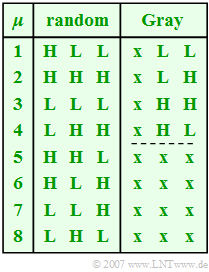Difference between revisions of "Aufgaben:Exercise 2.4Z: Error Probabilities for the Octal System"
| (One intermediate revision by one other user not shown) | |||
| Line 29: | Line 29: | ||
| − | + | Notes: | |
| − | |||
| − | |||
*The exercise belongs to the chapter [[Digital_Signal_Transmission/Grundlagen_der_codierten_Übertragung|"Basics of Coded Transmission"]]. | *The exercise belongs to the chapter [[Digital_Signal_Transmission/Grundlagen_der_codierten_Übertragung|"Basics of Coded Transmission"]]. | ||
| Line 66: | Line 64: | ||
{{ML-Kopf}} | {{ML-Kopf}} | ||
'''(1)''' According to the description on the specification page | '''(1)''' According to the description on the specification page | ||
| − | * | + | *$\rm LHH$ for the amplitude coefficient $a_{3}$ ⇒ $\underline{\mu =3}$. |
| − | * | + | *$\rm HLL$ for the amplitude coefficient $a_{8}$ ⇒ $\underline{\mu =8}$. |
| − | '''(2)''' The outer coefficients ( | + | '''(2)''' The outer coefficients $(a_{1}$ and $a_{8})$ are each falsified with probability $p = 1 \%$, the $M – 2 = 6$ inner ones with twice the probability $(2p= 2 \%)$. By averaging, we obtain: |
:$$p_{\rm S} = \frac{2 \cdot 1 + 6 \cdot 2} { 8} \cdot p\hspace{0.15cm}\underline { = 1.75 \,\%} \hspace{0.05cm}.$$ | :$$p_{\rm S} = \frac{2 \cdot 1 + 6 \cdot 2} { 8} \cdot p\hspace{0.15cm}\underline { = 1.75 \,\%} \hspace{0.05cm}.$$ | ||
| − | '''(3)''' Each transmission error (symbol error) results in exactly one bit error in | + | |
| + | '''(3)''' Each transmission error (symbol error) results in exactly one bit error in Gray code. However, since each octal symbol contains three binary characters, the following applies | ||
:$$p_{\rm B} ={p_{\rm S}}/ { 3}\hspace{0.15cm}\underline { = 0.583 \,\%} \hspace{0.05cm}.$$ | :$$p_{\rm B} ={p_{\rm S}}/ { 3}\hspace{0.15cm}\underline { = 0.583 \,\%} \hspace{0.05cm}.$$ | ||
| − | '''(4)''' Of the total of seven possible transitions (each in both directions) lead to | + | |
| − | *one error: | + | '''(4)''' Of the total of seven possible transitions (each in both directions) lead to |
| − | *two errors: | + | *one error: $\rm HLH \ \Leftrightarrow \ LLH$, |
| − | *three errors: | + | *two errors: $\rm HLL \ \Leftrightarrow \ HHH$, $\rm LLL \ \Leftrightarrow \ LHH$, $\rm HHL \ \Leftrightarrow \ HLH$, $\rm LLH \ \Leftrightarrow \ LHL$, |
| + | *three errors: $\rm HHH \ \Leftrightarrow \ LLL$, $\rm LHH \ \Leftrightarrow \ HHL$. | ||
Latest revision as of 09:19, 24 May 2022
A digital system with $M = 8$ amplitude levels ("octal system") is considered, whose $M – 1 = 7$ decision thresholds lie exactly at the respective interval centers.
Each of the equally probable amplitude coefficients $a_{\mu}$ with $1 ≤ \mu ≤ 8$ can be falsified only into the immediate neighbor coefficients $a_{\mu–1}$ and $a_{\mu+1}$, respectively, and in both directions with the same probability $p = 0.01$. Here are some examples:
- $a_5$ passes into coefficient $a_4$ with probability $p = 0.01$ and into coefficient $a_6$ with the same probability $p = 0.01$.
- $a_8$ is falsified with probability $p = 0.01$ into coefficient $a_7$. No falsification is possible in the other direction.
The mapping of each three binary source symbols into an octal amplitude coefficient happens alternatively according to
- the second column in the given table, which was generated "randomly" - without strategy,
- the Gray coding, which is only incompletely indicated in column 3 and is still to be supplemented.
The Gray code is given for $M = 4$. For $M = 8$ the last two binary characters are to be mirrored at the dashed line. For the first four amplitude coefficients a $\rm L$ is to be added at the first place, for $a_{5}, ..., a_{8}$ the binary symbol $\rm H$.
For the two mappings "Random" and "Gray" are to be calculated:
- the "symbol error probability" $p_{\rm S}$, which is the same in both cases; $p_{\rm S}$ indicates the average falsifcation probability of an amplitude coefficient $a_{\mu}$;
- the "bit error probability" $p_{\rm B}$ related to the (decoded) binary symbols.
Notes:
- The exercise belongs to the chapter "Basics of Coded Transmission".
- Reference is also made to the chapter "Redundancy-Free Coding" .
Questions
Solution
- $\rm LHH$ for the amplitude coefficient $a_{3}$ ⇒ $\underline{\mu =3}$.
- $\rm HLL$ for the amplitude coefficient $a_{8}$ ⇒ $\underline{\mu =8}$.
(2) The outer coefficients $(a_{1}$ and $a_{8})$ are each falsified with probability $p = 1 \%$, the $M – 2 = 6$ inner ones with twice the probability $(2p= 2 \%)$. By averaging, we obtain:
- $$p_{\rm S} = \frac{2 \cdot 1 + 6 \cdot 2} { 8} \cdot p\hspace{0.15cm}\underline { = 1.75 \,\%} \hspace{0.05cm}.$$
(3) Each transmission error (symbol error) results in exactly one bit error in Gray code. However, since each octal symbol contains three binary characters, the following applies
- $$p_{\rm B} ={p_{\rm S}}/ { 3}\hspace{0.15cm}\underline { = 0.583 \,\%} \hspace{0.05cm}.$$
(4) Of the total of seven possible transitions (each in both directions) lead to
- one error: $\rm HLH \ \Leftrightarrow \ LLH$,
- two errors: $\rm HLL \ \Leftrightarrow \ HHH$, $\rm LLL \ \Leftrightarrow \ LHH$, $\rm HHL \ \Leftrightarrow \ HLH$, $\rm LLH \ \Leftrightarrow \ LHL$,
- three errors: $\rm HHH \ \Leftrightarrow \ LLL$, $\rm LHH \ \Leftrightarrow \ HHL$.
It follows that:
- $$p_{\rm B} = \frac{p} { 3} \cdot \frac{1 + 4 \cdot 2 + 2 \cdot 3} { 7} = \frac{15} { 21} \cdot p \hspace{0.15cm}\underline { = 0.714 \,\%} \hspace{0.05cm}.$$
